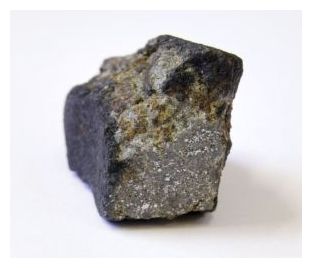
© Phil Bland
A unique meteorite that smashed into the West Australian outback last year is exciting the scientific world.
The ancient rock has an unusual composition and is being studied by scientists around the globe.
Now in the Natural History Museum in London, the meteorite is undergoing preliminary analysis and will be returned to the WA Museum when those tests are complete.
Curtin University department of applied geology Adjunct Professor Phil Bland said the meteorite, which is roughly the size of a tennis ball, could reveal vital clues to the origins of the universe.
Not only is its chemistry proving intriguing but scientists were able to track its fall to earth to determine where in the solar system it came from.
There have been more than 50,000 documented meteorite falls over the past 200 years but scientists know the origins of just 10, highlighting the importance of the latest find.
Meteorites are the oldest rocks in existence and contain a 4.56 billion-year record of solar system's formation and evolution.
The latest meteorite's orbit was tracked using a series of stargazing cameras set up in remote areas of WA under a special international project involving Curtin University, the Imperial College London, Ondrejov Observatory in the Czech Republic and the WA Museum.
The cameras capture the meteorites on their orbit to earth and, using a complex series of calculations, are able to pinpoint their crash sites within 100m.
"Because every rock has a precise orbit, our meteorites will be a unique sample set: researchers worldwide will be requesting this material for decades. So as the collection grows, in addition to the science that we're doing with it, I think that'll be good for the long term profile of Australian planetary science, and for all those institutions involved," Professor Bland said.
"Meteorites are like ancient jigsaw puzzle pieces. When we find out where one comes from, it is like putting in another tiny piece of the puzzle, providing insights into the workings of our solar system and how it began billions of years ago.
He said meteorites were a geological record of the formation of the solar system, providing important information about early conditions.
"Locating where they come from is important, because it enables scientists to link geological information to the correct location in space," he said.
"We've only really just started analysing (this latest meteorite). We've got a very precise orbit for it, so we're currently looking through the asteroid database to see if there's anything out there that matches it - that could have been the source for our rock. But in terms of composition, it does look kind of interesting."
Professor Bland said the meteorite tracking project could provide some fundamental insights into how the solar system and rocky terrestrial planets formed.
"This is a great time for planetary science. But we are kind of where geology was in the 1950s. We've still not had our 'plate tectonics moment' - a general theory that pulls all those pieces together. Thanks to plate tectonics we know how our planet works. We just don't know how it was made.
"Meteorites offer perhaps our most direct route to an answer."

the article doesn't get around to mentioning what this meteorite's "unusual composition" that is "exciting the scientific world" actually is. Also found the beginning of this sentence amusingly stupid - "The cameras capture the meteorites on their orbit to earth and..."